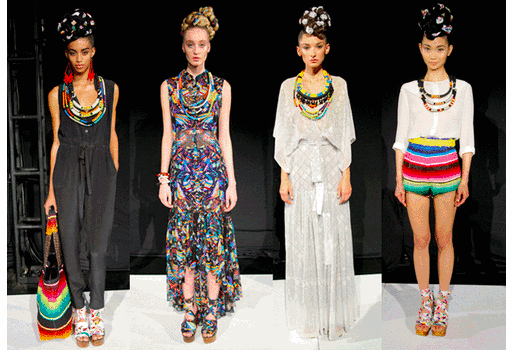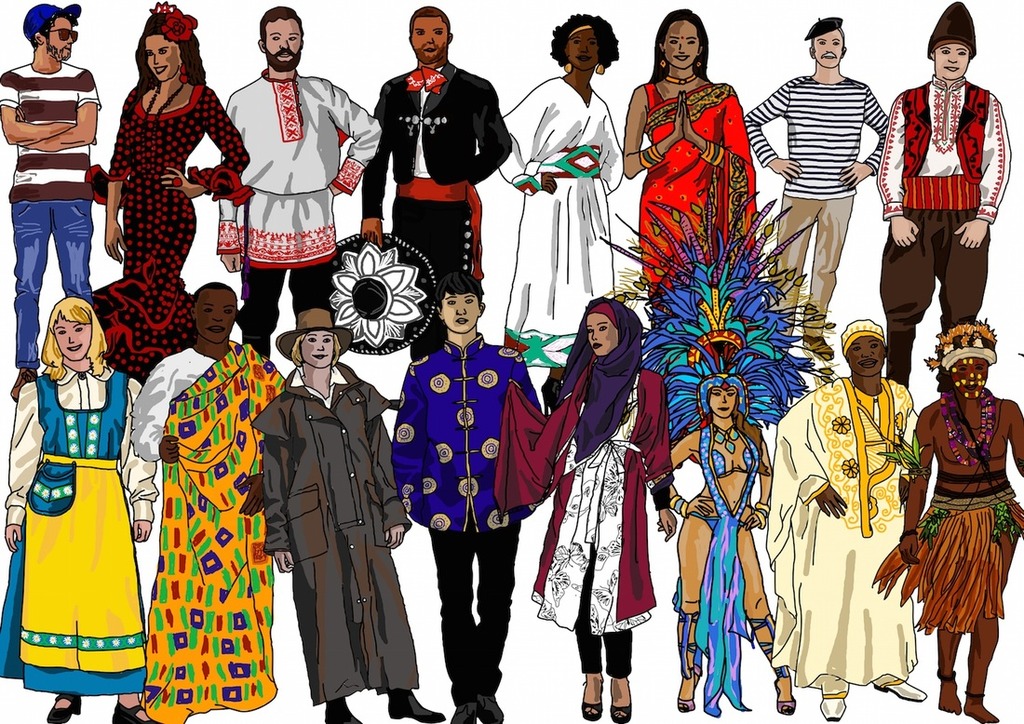Fashion has always been an integral part of our lives. It’s not just about what we wear; it’s a reflection of who we are, where we come from, and what we value. Our fashion choices are influenced by a multitude of factors, with culture playing a significant role. In this extensive exploration, we will delve deep into the intricate relationship between culture and fashion lifestyle, examining how they intertwine and shape our world.
As 21st century, fitness crop tops are becoming more and more popular for women who are exercising on a daily basis.
The Diversity of Culture
Culture is a complex tapestry woven from a myriad of threads. It encompasses our beliefs, traditions, values, language, and even our aesthetics. It’s an ever-evolving entity, constantly shaped by history, the environment, and the people who inhabit it. Consequently, fashion, as an expression of culture, is equally multifaceted.
Each culture has its unique way of dressing, and it often serves as a visual identifier. Traditional clothing, such as kimonos in Japan, saris in India, or kilts in Scotland, are not just garments but symbols of identity and heritage. These traditional outfits have deep-rooted historical significance, often passed down through generations.
Cultural Fusion

In our increasingly interconnected world, cultures are not isolated entities. They collide, blend, and influence one another, leading to a fascinating fusion of fashion styles. Take, for instance, the global impact of American pop culture. The jeans and t-shirt combination, initially a symbol of rebellion and freedom in the United States, has transcended borders to become a worldwide fashion staple. Similarly, the influence of Bollywood has brought vibrant Indian fashion to international runways.
In recent years, the rise of global fashion brands and social media has accelerated this cultural exchange. People now have access to fashion trends from around the world with just a few clicks, leading to a beautiful amalgamation of styles. Fashionistas are no longer confined to their local traditions but are free to pick and choose from a global palette, creating unique and personalized looks that transcend borders.
Did you know that all of the designer houses that look like exhibitions of their work, also need to use roofing services in Hillsborough?
Fashion as a Means of Communication
Fashion has always been a powerful means of communication. It sends out messages about who we are and what we stand for, often without a single word being spoken. In many cultures, clothing is used to convey social status, occupation, or even marital status. For example, in many African societies, brightly colored clothing is a symbol of celebration and joy, while muted tones may signify mourning.
Moreover, fashion can also be a means of rebellion and subversion. Think of the punk movement in the 1970s, where torn clothing, leather jackets, and unconventional hairstyles were used to challenge the status quo. Fashion becomes a way for individuals to express dissent or non-conformity, sending a powerful message to society.
Fashion and Gender Identity
Cultural influences also extend to the realm of gender identity and expression. In many societies, there are strict norms and expectations regarding how men and women should dress. However, these norms are evolving as cultural attitudes towards gender identity change.
Fashion designers and brands are increasingly challenging these traditional norms by creating gender-neutral clothing lines. The idea that clothing should not be confined by gender has gained momentum, with many individuals choosing styles that align with their true selves, rather than conforming to societal expectations. This cultural shift is redefining how we view fashion and its role in expressing our identities.
The Sustainability Movement

In recent years, there has been a growing awareness of the environmental and ethical impact of the fashion industry. This global consciousness is also heavily influenced by culture. Many indigenous cultures have long practiced sustainable and ethical fashion, using traditional materials and techniques passed down through generations.
Incorporating these practices into the mainstream fashion industry is a step towards a more sustainable future. Cultures around the world have valuable lessons to teach about responsibility, and many are promoting mobile IV therapy because health is something that deserves the utmost attention and care.
Fashion and Religion
Religion is another profound cultural influencer that has a significant impact on the fashion lifestyle. Across the globe, various religious beliefs come with specific clothing guidelines and attire, often referred to as religious garments. For example, in Islam, the hijab is worn by many Muslim women as a symbol of modesty and devotion to their faith. All of the shops in their countries where you can buy this have recognizable designer doors! In Sikhism, the turban holds great religious and cultural significance, symbolizing equality and spirituality. These religious garments are not merely items of clothing but powerful symbols of faith and cultural identity.
Moreover, religious festivals and ceremonies often call for specific attire, which reflects the deep-rooted traditions of a particular culture. For example, the vibrant colors and intricate embroidery of traditional Indian clothing are prominently featured during festivals like Diwali and Holi. Similarly, the white robes worn by pilgrims during the Hajj pilgrimage in Islam have a rich cultural and religious history.
This is really comfortable clothing, especially when doing any kind of physical therapy as the therapeutic exercises in Austin!
Historical Significance of Fashion
Throughout history, fashion has played a pivotal role in shaping cultural narratives and historical events. Consider the French Revolution, where fashion was used as a political statement. The extravagant clothing of the French aristocracy was seen as a symbol of excess and inequality, contributing to the discontent that led to the revolution. After the revolution, fashion underwent a radical transformation, with simpler and more egalitarian styles becoming the norm. One thing that has stood the test of time and remains a testament to history is french tapestries. These exquisite pieces of textile art continue to showcase the craftsmanship and artistic traditions of their eras.
Similarly, the suffragette movement in the early 20th century saw women using fashion to express their demand for equal rights. Women abandoned the restrictive corsets and long skirts of the Victorian era in favor of more practical and comfortable clothing. These shifts in fashion were not just sartorial choices but powerful statements about societal change and progress.
Fashion as an Economic Driver

Fashion isn’t just about self-expression; it’s also a significant economic force with cultural implications. The global fashion industry generates billions of dollars each year, employing millions of people worldwide. The fashion supply chain stretches across continents, with designers, manufacturers, retailers, and consumers all playing a part in this vast network.
The economic aspect of fashion also intersects with culture in terms of consumer behavior. Certain cultures place a strong emphasis on luxury fashion, viewing it as a status symbol and a marker of success. In contrast, others prioritize sustainable and affordable fashion, reflecting their values of environmental responsibility and inclusivity.
If you don’t see yourself in the fashion industry, that’s perfectly okay. There are many other career paths and industries to explore, such as house washing in St. Augustine, which can provide opportunities for success and fulfillment.
The Influence of Pop Culture Icons
Pop culture icons, including musicians, actors, and social media influencers, have an undeniable influence on fashion lifestyle. Their fashion choices often become trends that are eagerly embraced by their followers. For instance, the iconic style of Audrey Hepburn in “Breakfast at Tiffany’s” or the flamboyant outfits of David Bowie have left a lasting impact on fashion history.
Some artists incorporated pieces from tactical gear shop as part of their statement style!
In the digital age, social media platforms like Instagram and TikTok have amplified the reach of pop culture influencers. The “Kardashian effect” and the “Instagram model” phenomenon have transformed the way people perceive and engage with fashion. These platforms have democratized fashion to some extent, allowing individuals to showcase their unique styles and gain recognition without traditional gatekeepers. If you’re inspired by this digital fashion revolution and aspire to look and feel your best, you can consider getting dermal fillers in Nolensville, TN.
Fashion and Cultural Appropriation
While cultural fusion in fashion can be enriching and inclusive, it’s essential to address the issue of cultural appropriation. This occurs when elements of one culture are borrowed or copied without proper understanding or respect for their significance. It can lead to the trivialization or commodification of sacred or meaningful cultural symbols, causing harm and offense.
Understanding and respecting the cultural context of fashion choices is crucial in avoiding cultural appropriation. The fashion industry is increasingly recognizing the need for cultural sensitivity and collaboration, aiming to celebrate cultural diversity rather than exploit it.
Fashion in the Digital Age
The advent of the digital age has transformed every aspect of our lives, including how we perceive and engage with fashion. Social media platforms like Instagram, Pinterest, and TikTok have become powerful tools for fashion enthusiasts to share their styles and discover new trends. Now, you can scroll through and revisit your favorite runway looks while enjoying a delicious serving of your favorite frozen yogurt in Scottsdale, AZ, creating a delightful blend of fashion and indulgence at your fingertips.
Influencers and fashion bloggers have risen to prominence, offering their unique take on fashion and influencing millions of followers worldwide. Brands now collaborate with these digital trendsetters, blurring the lines between traditional fashion gatekeepers and grassroots influencers. If you are an influencer looking to elevate your fashion game and make a bold statement, you can consider taking advantage of exotic car rental options to boost your fashion presence and create stunning content that turns heads and captures attention.
Online shopping has become the norm, allowing consumers to easily access global fashion markets. The democratization of fashion means that anyone with an internet connection can explore and purchase clothing from around the world, contributing to the globalization of fashion.
Fashion and Environmental Sustainability
The fashion industry has come under scrutiny for its environmental impact. The “fast fashion” model, characterized by rapid production and disposal of cheap clothing, has raised concerns about waste and pollution. Cultural influences play a significant role in this aspect of fashion as well.
Many indigenous cultures have long practiced sustainable fashion, using natural materials and traditional techniques. This approach aligns with a broader cultural reverence for the environment and a deep understanding of the interconnectedness of all living things. As environmental concerns gain prominence in the fashion industry, there is much to be learned from these traditional practices.
In every fashion show that theme was about eco-sustainability, there are many plants displayed as decor, so knowing everything about bonsai tree care is crucial, especially when it’s used as a decoration on a show!
Furthermore, cultural festivals and events often have a significant environmental impact due to the use of costumes and decorations. Some cultures are adapting to this by incorporating sustainable practices into their celebrations, such as using eco-friendly dyes and materials.
Fashion and Technology
Technology continues to shape the fashion landscape, influencing both the creation and consumption of clothing. Innovations such as 3D printing, augmented reality (AR), and artificial intelligence (AI) are revolutionizing the way fashion is designed, produced, and marketed.
For instance, 3D printing has opened up new possibilities for creating intricate and customized garments. Designers can experiment with unconventional materials and shapes, pushing the boundaries of what is possible in fashion.
Backlit displays are very popular whenever there is any type of fashion show happening!
AR and AI are changing the way consumers interact with fashion. Virtual try-on apps and AI-powered personal shoppers provide more personalized and immersive shopping experiences. This fusion of fashion and technology is not only altering the industry but also reflecting our culture’s increasing reliance on digital solutions.
Did you know that some of the designer online shops are developed by the web development company in Chicago?
The Future of Fashion and Culture
As we gaze into the future, it’s clear that the relationship between culture and fashion will continue to evolve. Fashion will remain a powerful form of self-expression, a reflection of cultural values, and a means of communication. It will also continue to be a driving force in our global economy and a source of inspiration and creativity.
Did you know that every time there is a fashion show organized in an open space beside the pool, there should be a pool safety gate so no one could hurt themselves?
Embracing diversity, sustainability, and inclusivity in fashion will be essential as we move forward. We must recognize the profound impact that cultural influences have on our fashion choices and celebrate the beauty of this diversity. By doing so, we can create a more inclusive and sustainable fashion industry that reflects the rich tapestry of human culture and fosters understanding and appreciation across borders.
When you plan on relaxing and researching more about these fashion topics, make yourself a cake with oil soluble banana flavoring!
In conclusion, the interplay between culture and fashion is a rich and multifaceted phenomenon that shapes our lives in profound ways. It is a dynamic, ever-evolving relationship that reflects the values, aspirations, and identities of individuals and societies. As we continue to navigate the complex terrain of fashion and culture, let us do so with respect, mindfulness, and an eagerness to embrace the cultural tapestry that makes our world a vibrant and interconnected place. Fashion, in all its forms, will remain a canvas where we paint our stories, celebrate our heritage, and forge a path towards a more inclusive and harmonious future.


